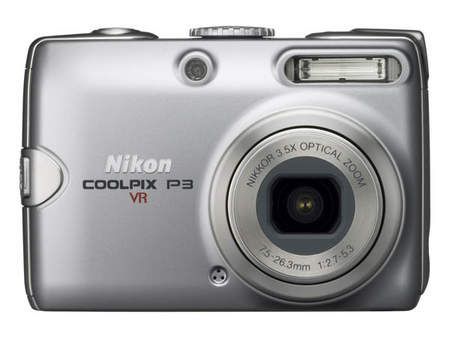The Nikon Coolpix P3 slips into the Coolpix range above the P1 and P2 and alongside the otherwise identical P4, identical that is apart from the P4 lacks the WiFi connectivity found on the P3.
Our quick take
Overall, image quality is superb, some frame filling shots of colourful rugs are so detailed and sharp that even stray carpet fibers are clearly defined in the photos.
Colour is natural and pixel fringing is kept to an admirable minimum while highlight detail is well controlled. Additionally, while the flash is underpowered, as a fill in flash unit it works well assisted with some aplomb by some superb flash metering.
An 8.1-megapixel digital compact replete with so much neat kit and costing a tad under £350 looks a superb bargain.
Here, if you add the P3’s surefooted handling, neat styling and build and the great image quality then quite simply, that is exactly what it is.

Nikon Coolpix P3 digital camera - 4.5 / 5
| FOR | AGAINST |
|---|---|
|
|
Top of the specification otherwise, is an 8.1-megapixel CCD sensor providing resolution enough for large prints or for cropping a full resolution image.
Another key feature is the 3.5x optical zoom Nikkor lens, which has Vibration Reduction or VR, Nikon’s term for optical image stabilisation. It can reduce camera shake in low light or at full zoom for example.
The lens meanwhile provides a 36-126mm zoom range with a F2.7 maximum aperture. Significantly, the VR means you can hand hold low light shots or those at taken at slower shutter speeds (compensation up to around to exposure steps) without as great a risk of camera shake blurring the shot.
Another significant feature of the P3 is its AF system, which sports a wide field 11-point set up with each AF zone receiving extra pixels on which to work, in theory making the AF more accurate. In practice, seemingly the theory is borne out.
There are three key shooting modes outside the camera’s many scene modes, of which more in moment. You get a point and shoot setting where the camera does the work for you; a Program mode allows a modicum of user override via exposure compensation and Aperture Priority completes the main shooting options. The latter allows you to set the required aperture (between F2.7 and F7.6), the camera helpfully fires up an active histogram as well so you get an idea of how the exposure is affecting the image prior to snapping.
The 16 scene modes on board the P3 are very similar to those of the recently tested Coolpix L3 (and most other Coolpix models for that matter) and include the innovative Face Priority AF, where the camera can recognise and track a human face ensuring it’s always sharp even for a moving subject. There are the "usual" array of other scene modes such as landscape, night scene and indoor/party settings, but you also get extra levels of tweakabilty for some settings. These advanced scene modes provide extra effects, in portrait mode for example, there are two tweaks on offer: "Effect 1" brightens skin tones while "Effect 2" adds a soft filter effect to the image.
Nikon’s D-Lighting is in the mix as well, this provides a way to recover lost detail in underexposed images by boosting picture detail and brightness in camera, and the down side of this can be increased noise however.
This techno wizardry is not over awing to use however, thanks to a neat control layout that sees the top plate graced with a shutter release joined by the on/off button, a centrally placed mode dial accessing the main shooting options, Wi-Fi connectivity (more on that in moment) and finally the VR button that activates the anti shake system.
On the back plate, a large, bright and clear 150k-pixel 2.5-inch colour screen is joined by the zoom control, menu button a playback and delete button; there’s no optical viewfinder though. A largish four-way jog button fulfils scrolling duties in (easy to use) menus and image playback and activates the flash modes, self-timer, and exposure compensation and macro modes.
The IEEE 802.11g (and b) Wi-Fi set up is a neat addition to the camera and when properly set up (which can be a bit of a challenge, I found it less than straight forward) allows direct wireless printing via compatible printers and connecting the camera to a PC for offloading images directly to a hard disc without the need of a cable. You can of course still connect via a supplied USB cable if desired.
So, the P3 is jammed with goodies, but how good are the results? For a kick off the detail it’s possible to capture is superb, the lens and CCD working well together. I’ve discussed the AF system which works well (though macro focusing was a challenge on some subjects) while the metering (all 256-segments of it) works a treat too, though some images were mystifyingly overexposed and I did not get to the bottom of the problem. It’s probably me though.
Noise is controlled well at all sensitivities up to ISO 200, at ISO 400 things get a tad noisier than I’d like and the limited sensitivity available (ISO 400 is the top setting) is attributable to the camera possessing VR; you don’t need the higher settings to get a reasonable shot in lower lighting. All those lovely images can be stored either on the 23MB of internal memory or on external SD/MMC storage.
To recap
It boasts a raft of neat features making this a desirable and accomplished little camera
